In part one of Pulse’s roundtable discussion, GP leaders discussed what elements of the partnership model are no longer fit for purpose.
Here they discuss the changes required to make partnerships more appealing.
How important is working at scale?
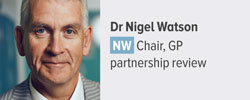
roundtable nigel watson 250x100px
NW I absolutely believe having a registered list, working for your registered population and providing services and organising around that is critical, and is one of the reasons we’ve got one of the most cost-effective health services in the world. It hasn’t got the best outcomes at the moment and I think there are all sorts of reasons for that.
You may form a superpartnership and that may work well, or you may work in a network of three practices.
Working at scale is not ‘ I want you out of your practice on a Thursday to work in my hub over there’, but it may be that actually what you want to do is three days a week in the practice and actually a day a week of diabetes, which is community based.
Where I work frailty is a big issue. We’ve got a high elderly population, we need more of those services which you wouldn’t embed at practice level but you might develop at a locality level.
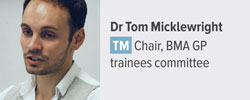
roundtable tom micklewright 250x100px
TM When people come out of their training they see so much more opportunity than perhaps there was ever before. Young doctors now can work anywhere in the globe. GPs are in demand in A&E departments, hospital outpatients, prisons, across all sorts of different specialities and fields.
I think perhaps one advantage of the kind of larger models – of cluster working or federations – is that potentially they can offer opportunities for growth.That’s not to say that smaller, individual practices or rural practices can’t offer those as well.
We’ve just got to pay attention to creating some sense of progression. Historically, partnership has felt a little bit like a plateau, like the peak of your career and then there’s nowhere else to go.
NW Look at the issue of people with young kids: if you’re working in a bigger unit, there is no reason why you can’t look at roles where such people work from 9.30am-2pm term time and then as the kids grow up they develop their career and you give them incentives to do it.
You can’t do that in a two-person practice because who covers the early morning and the late evening? That’s not saying every practice needs to merge to a super partnership, but we do have to think differently.
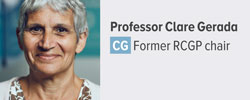
roundtable clare gerada 250x100px
CG In our practice we have about 90 to 100 doctors, most salaried, and eight partners. We offer total flexibility because we’re large enough, so you can do as little as one hour a week from home, or as much as eight clinical sessions. You can do chronic disease management, you can do results only.
We’ve recently advertised for new partners. When we advertised three years ago we got zero, more or less. When we advertised last year, we actually had 13 people who applied and we whittled that down and we managed to appoint two. I’m now looking for more partners.
NW I don’t think superpartnerships are the only model but indemnity is key if they are to work. Working at scale, the issue is having a comprehensive scheme that covers everybody working in primary care. That would be hugely valuable for the system, let alone for us as individuals.
The second issue is, I think some of those practices that work together will need to start trusting each other and forget the fact there was an argument in the car park 30 years ago!
Is working at scale compatible with continuity of care?
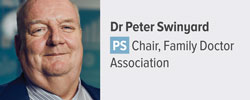
roundtable peter swinyard 250x100px
PS I think, even if you work at scale, you can still arrange it to have continuity of care. It just takes more thought and work.
NW I think if you go to big units, the risk is to depersonalise it and you become just one of a number.
What we’re seeing in a number of big practices is that they form micro-teams with two or three GPs working with a nurse practitioner and an admin person. They’re responsible for 3,000 or 4,000 patients and they know that group well so there is continuity.
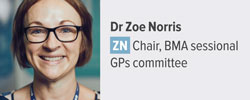
roundtable zoe norris 250x100px
ZN You can’t have continuity all the time, and have access. The Government has to decide which way it’s going, and where it’s going to put the money.
TM I don’t think it has to be continuity versus access. We know that for some patients access is more valuable and for others continuity is. You’ve only got to look at the thousands of people that suddenly joined Babylon’s GP at Hand.
SdG I think fragmenting of care in the name of access has to be stomped on hard. In East Kent we have hubs where a GP is literally paid to sit and watch TV all Sunday – it’s prebooked appointments only but nobody’s there because people didn’t want appointments on Sunday.
How is the role of the GP changing?
ZN One of the main reasons I became a GP was I didn’t like being told what to do. I felt that as a partner that was taken away from me – I was being told what to do by various organisations. I moved into sessional work to get that autonomy back. I lost my vocation when I got burned out as a partner.
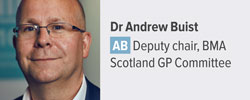
roundtable andrew buist 250x100px
AB The Scottish Government has understood that the expert medical generalist is a key role, and it’s about being equal with consultants. We shouldn’t be signing piles of prescriptions and doing PSA bloods – we should be doing undifferentiated care that the advanced nurse practitioner can’t do, complex care, treating people with several long-term conditions and leading an expanded primary healthcare team.
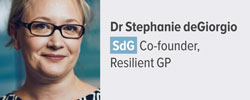
roundtable stephanie de giorgio 250x100px
SdG We have to acknowledge people want to do different things and I think working at scale absolutely comes into that. We have to look at how our individual days are structured: a morning surgery, break, visits, afternoon surgery scenario is very old-fashioned.
The other thing – something that isn’t talked about that often – is the difference between female and male GPs. The majority of the workforce who leave are women in their 30s, highly trained, skilled GPs. There’s a vast number of reasons for this but a story that comes up more and more is that some female GPs are spending many of their surgeries, if not all, doing gynaecology and psychiatry.
That doesn’t fit in 10-minute slots but the way most surgeries are set up doesn’t allow the time for GPs who have different areas of skill for things that take longer.
NW I totally agree. I know two practices where there’s a younger GP and an older GP and they do a month on and a month off each and that works well for them.
We’ve got a women’s health clinic that one of our female doctors does, with longer appointments. In a bigger unit you can look at how you develop services in this way.
Mental health is an even bigger issue. If we had a community service with a community psychiatric nurse we would not only reduce the people going into secondary care, but we’d manage our population much better.
Are we moving to GPs specialising in certain areas of practice?
NW You have to move away from the mentality of ‘I’m the oldest doctor, so I’m the senior partner so I’ll do everything’. In my practice we have a number of subcommittees – for finance, education, IT, and the executive committee. In terms of succession planning, some people are identifying they enjoy leadership or finance, so let’s nurture those people.

roundtable hina shaid 250x100px
HS I do have a lot more flexibility so I can have a mix of types of appointments, face to face and telephone, and I’ve also taken on palliative care.
However, we’ve got a GP who leads on diabetes so I feel deskilled as I can’t prescribe for diabetes anymore. But it works well for patients.
CG We are the only GPs in the world that see everybody from birth to death and beyond, and the reason the NHS works is because of that system of general practice. The more you specialise, the less you will see. I think you should develop a special interest where you add generalist values, for example care of homeless, the very elderly or the prison population.
What concrete changes would attract more trainees into partnerships?
TM I think we need a more financially viable option for new trainees. Limited liability partnerships are a great idea if we can secure that and, similarly to Scotland, if the Government takes over premises leaseholds that would be fantastic.
AB The intention in Scotland is, over 25 years, partners will be bought out of their premises. Those that have leases will be taken over by the health board.
Practices that want to continue owning their premises can do so.
In the 1950s when we worked out of Victorian houses you could convert them back into a house and sell them if things went badly but now premises are sophisticated and purpose built you can’t use them for anything else. So young doctors don’t want to invest their buying power in them and be left last man standing.
NW We are looking at the technical side of the business model and we are looking at limited liability partnerships.
In terms of premises, I don’t think we’ll get to where Scotland has got to but I think there is an element of, if a practice with a 20-year lease hands its contract back, it isn’t responsible for the lease, so the NHS could take the responsibility.
Most of those purpose-built premises, they still need general practice services within that building.
I think there is a way that you can look at the leases where it doesn’t mean that all GP practices with a lease can relinquish the lease and somebody’ll take it. I think there is an interim stage, which is again what we’re exploring.
TM The final thing I’d like to say from a trainee perspective is that the most common reason I hear for wanting partnership is the wish to be fully autonomous. I think that’s been under-emphasised. I think there are so many things stripping that autonomy away – from referral management, to contracts we’re chasing that we don’t agree with.
I dare say a payment by activity model might mean we’re chasing fewer targets.
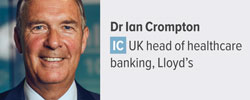
roundtable ian crompton 250x100px
IC I’ve had interesting conversations that suggest one of the biggest blockers to progress is senior partners. New partners come in and they block the premises moves and everything on the back of their interest. That’s one of the things that stops change in primary care I think.
One thing under consideration is financial training of new doctors and I think there could be more of that, because I think there are myths around.
NW As an LMC, we talked to the RCGP about putting more of that in the training but the curriculum is fairly heavy already.
One of the things we’re thinking of doing is engaging with younger GPs and perhaps post training putting on a series of events that may look at finance, HR, and other things that would be of interest to develop their career.
How can we control workload?
HS As a relatively newly qualified GP, somebody considering a partnership, I think the most important things are around having control of workload.
I feel at the moment we just don’t have any. For example, the referral system – we have to do it a certain way because that’s what the CCG wants. When we’re on call we can see 50 or 60 patients and that’s just the way it is and we don’t feel empowered enough to say this is unsafe.
NW Workload is a really important issue but we can’t say ‘right, it’s 4 o’clock I’ve seen so many patients we’ll stop now’ – because where do they go?
I don’t think it’s a case of saying we see 25 in a day and that’s it, but we should be asking what is a reasonable amount of time to work. I don’t think 14-hour days are safe.
Pulse July survey
Take our July 2025 survey to potentially win £1.000 worth of tokens














